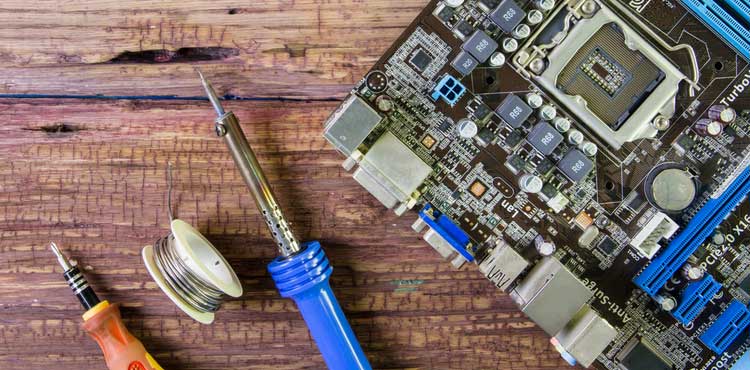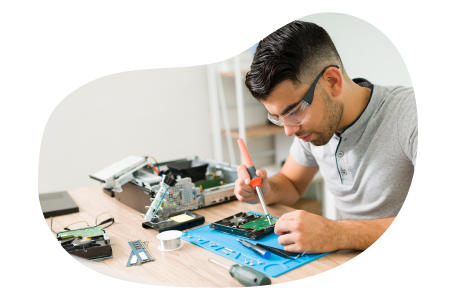
Whether leasing a storefront or working from home, tech experts starting their own computer repair business will need to invest a lot of time and money into planning, promoting, and protecting their new venture to help it succeed.

Table of contents:
The ability to configure a motherboard or coax a CPU into place are valuable skills, and those who have the technical chops can become a hot commodity. But what about tech experts who dream of being their own boss? If you have a knack for fixing electronics, starting a computer repair business could be a logical career move.
However, you shouldn’t take that decision lightly. Writing a business plan, securing financing, and taking several other key steps may be needed to put your best foot forward with your new IT company.
If you think you’re ready to open your doors and offer your tech expertise to customers directly, you can follow these helpful steps to successfully launch your computer repair business.
When starting a computer repair business, it’s important to shore up on your savings to help cover the essentials before working with your first customer. These expenses may include:
On top of these startup costs, it’s also a good idea to keep emergency cash on hand. This gives you some flexibility as your company grows, as it can cover your business expenses during months when you don’t hit your billable work goals.
Ideally, you should keep enough money to cover your expenses for at least six months before quitting your day job and starting your own computer repair business.
Protect your computer repair company with business insurance Get Quotes
Your business plan will serve as the cornerstone of your small business – whether you run a laptop repair service from your kitchen table, or from the inside of a large IT repair and maintenance company with several employees.
When you write a business plan, it should include both your ideas for getting your new computer repair business up and running, as well as plans for how you’ll grow and adapt in the future. Here are some of the most important questions you should answer in your business plan to help guide your new company.
IT and computer repair is a broad field. Your business plan should include a “shortlist” of services that your computer repair company will specialize in. You could choose from several different specialties, including server maintenance, personal computer repair, and more.
Deciding who your target customers are – individuals, businesses, or both – will help you better understand their needs and how your computer repair business can help them. Your business plan should include a profile of your target customers and a plan for reaching them.
How you choose to structure your business can affect both your taxes and legal liability. Most companies choose one of three options:
Where you choose to conduct business will directly impact your expenses, business insurance needs, and customer relationships. For example, if you decide to offer computer repair services from your home, you’ll likely need a business vehicle and commercial auto insurance.
Most computer repairs companies operate from their own home, a storefront, or on-site with clients.
Your business plan should include a strategy for financing your startup costs and operational expenses until you’re profitable. Some small business financing options include small business loans, partnering with outside investors, and crowdfunding.
You should accurately analyze your competition in your business plan. Understand their strengths, weaknesses, and how you could fill a gap in your market. You should also note their marketing strategies and how they might make it difficult for your new computer repair company to gain traction.
Setting goals in your business plan shows that you’re committed to your computer repair business. It forces you to consider the costs involved and develop a vision for where you want your company to go in the future.
Your business plan should cover how you’ll get the word out about your new company. This section should include both your strategy and the costs associated with it. Consider attending networking events, email marketing, and SEO-based advertising to help you get started.
Hiring employees can help take some work off your plate and allow you to scale your business. If you think you’ll hire employees eventually, your business plan should answer when you will look to hire, what business goals you need to hit to afford that, and what types of employees you'll need.
After outlining your finance options in your business plan, the next step is to seek out what options are readily available to help get your computer repair business off the ground.
To start, one option you can consider is a loan through the Small Business Administration (SBA). The SBA partners with lenders, community development organizations, and microlending institutions to set guidelines and facilitate loans for small business owners.
The SBA’s support reduces overall risk for lenders, making it easier for you to get approved for financing than you would through a traditional bank loan.
However, an SBA loan may not cover all your needs. In that case, you could try to leverage any of these options to provide additional support:
Each of these options comes with risks. For example, credit cards typically have high interest rates compared to other business loans, and borrowing from friends and family risks damaging your personal relationships if your business should fail.
For this reason, you should try to run your computer repair business as lean as possible in the beginning. Doing so will minimize the amount of money you need to borrow and allow you to focus on building your business rather than repaying debt.
Depending on the types of services you’ll offer, you could have a lot of location flexibility when you start your new computer repair business. For example, if you fix computers online, you may only need a home office with a secure internet connection to get started. Or, if you decide to offer on-site repairs, you may not need a physical location at all.
How you choose to operate will ultimately determine your location needs, which you’ll eventually choose from one of these three options:
Running a home business reduces your overhead since you don’t need to pay for office space. On top of that, your commute is nonexistent, and you typically have more flexibility over your work hours.
However, there are some downsides. It may be tough to separate your professional life and personal life. Also, if you ever work with your customers face-to-face (IT consultations, dropping off laptops for repair, etc.), you’ll either need to meet them somewhere else, or invite them to your home. You’ll also need to purchase commercial property insurance as most homeowners’ policies don’t cover business property.
Because of this, running your computer repair business from your home is best if you fix computers online, offer in-home computer repair services, or work on-site with local businesses.
A storefront lets people in your community see your business name and brand. It can draw foot traffic and gives you a set location to interact with customers who may be dropping off their computers for repairs or stopping in to ask questions.
The biggest downside of a storefront is the additional expense. Not only will you pay rent or a mortgage (if you decide to buy instead of lease), but you’ll also have other expenses such as utilities. On top of that, you’ll likely need to purchase general liability insurance and commercial property insurance to protect both you and your landlord from lawsuits and property damage.
If you include a retail section to sell computer accessories, you will also need to consider the wholesale costs of the products you plan to sell, as well as invest in product liability insurance.
If you offer at-home computer repair services, you may not need a physical location for your business. Instead, you’ll go to your customers’ homes to repair their computers and troubleshoot other technical problems.
If you prefer to work with businesses instead of individuals, you can also run an on-site computer repair company where you’ll maintain their servers, install new hardware, and repair their company laptops and computers.
Limiting your repairs to on-site visits eliminates the added expense of a storefront while also separating your personal and professional lives. However, there are other factors to consider, including:
Since you’ll be driving to your customers, you’ll also need to purchase commercial auto insurance, since most personal auto policies exclude business-related driving.
You may also like
It’s never too late to fulfill your dreams and set up your small business from home. Here are 11 high-tech business ideas to help you jump-start your career as an entrepreneur.
It can be tempting to offer below-market pricing when you first start out. However, this strategy can backfire. Your customers will expect your low prices to continue, making it harder to raise your rates in the future.
Plus, you run the risk of being seen as the “cheaper” option rather than the high-quality one. This could attract customers who are more interested in the cheapest rate rather than high-quality service. Once your rates increase, these customers could disappear, forcing you to build your customer base from scratch.
When you get into this low-price cycle, you’ll have to take on more customers to cover your business expenses and pay your salary.
Research the typical rate for other repair shops in your area and set your prices accordingly. You should aim to be in line with what your competition is charging, while also accounting for your own expenses.
In most states, all you need to open a computer repair business is the expertise to do the work. However, you would likely benefit from obtaining certain certifications that prove your expertise and help you gain a competitive advantage. Some of the more common certifications for IT professionals include:
Certifications can help businesses of all sizes – from large commercial IT companies to freelance computer technicians. However, these credentials and courses aren’t one-size-fits-all. Check to see which certifications are common among other repair shops in your area and search online for common certifications in your industry to learn about the latest trends.
Asking family and friends to spread the word about your new business can help you build some initial buzz, but you also need a comprehensive marketing strategy to help potential customers find you.
Your first priority should be creating a website for your computer repair business. Use the website to share information about what you do, who you work with, and how to contact you. Your website should be professional and mobile-friendly. To make sure it meets these standards, consider hiring a professional web designer to build it for you.
Your company website will also be your hub for search engine marketing (SEM), where you’ll optimize keywords and content on your site to help you show up in the search results when people look for terms like “computer repair company” or “freelance computer technician.”
But marketing doesn’t stop with your website. You’ll want to invest in other strategies as well. Some ideas for marketing a computer repair business include:
It’s important to make marketing part of your regular schedule. Set aside a few hours each week to touch base with current and potential business clients, post on your social media accounts, and use email or other popular mediums to promote your business.